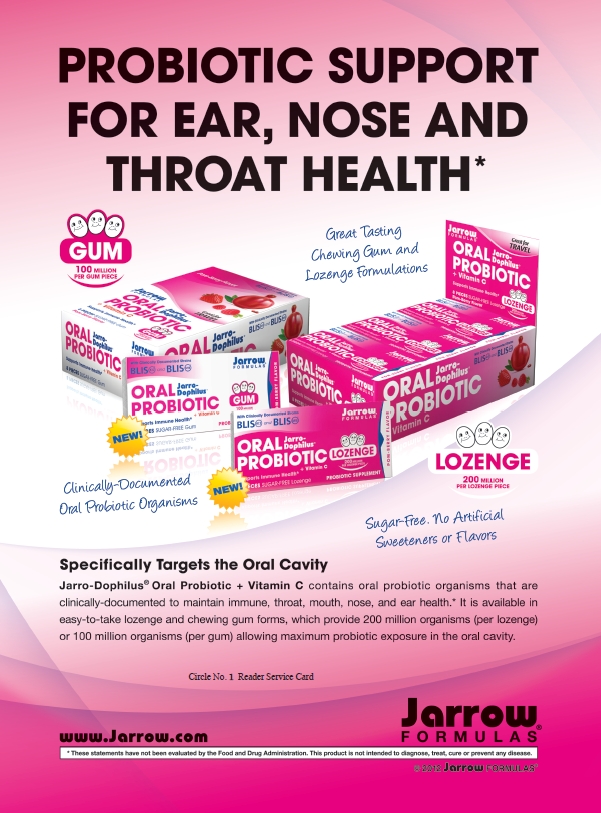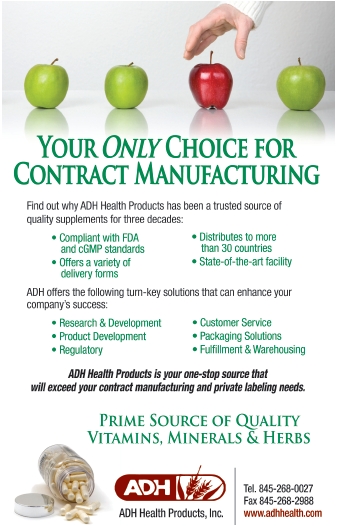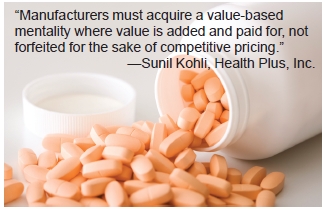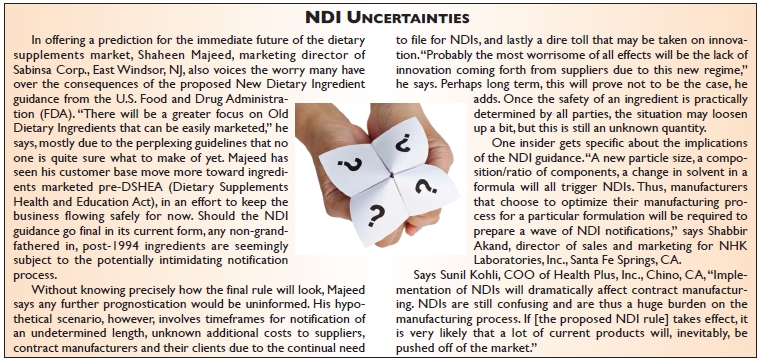The mark of a first-rate contract manufacturer is a unique flexibility in fulfilling client needs. Beyond the basic capability to churn out products from an assembly line, true manufacturing partners are well-positioned to make a product run work for you. They strive for this positioning primarily by addressing cost, regulatory compliance and service offerings. In what follows, manufacturing executives will discuss how these factors add up to a solid foundation for client partnerships. We’ll also find out what’s trending in the contract manufacturing world, and how reliable manufacturers can help their clients to roll with the economic times.
Manufacture with Confidence
Contract manufacturers must be strong in many areas to secure the trust and the repeat business of their clients. One of these focuses is quality assurance, and today’s atmosphere featuring consumer safety concerns and government crackdowns pushes this right to the forefront. “Quality certifications are important, particularly in today’s global, multi-cultural world,” says Shaheen Majeed, marketing director of Sabinsa Corp., East Windsor, NJ.
Many versatile contract manufacturers will eliminate the need for manufacturing middlemen. It is helpful if a manufacturer can minimize the number of players involved by performing intermediate production steps like blending, milling and granulating, according to Majeed. He gives his firm as an example: Sabinsa possesses many of the extracts used in the supplement industry, so clients can come to the company for ingredient blending and other pre-processing necessary before the final tableting phase.
The mere capacity to fulfill certain manufacturing needs is of little use without the proper background knowledge, Majeed notes, particularly because not all ingredients are processed the same way. “Experience with a variety of types of ingredients allows a contract manufacturer to more efficiently process things and minimize quality problems,” he says. Part and parcel of that experience is the ability to foresee potential issues with a product formula and to then bring the client into the loop. “We often give suggestions or advice on improving a formulation, should the customer request our opinion. For instance, there are situations in which softgels are not an optimal format,” says Steve Holtby, president and CEO of Soft Gel Technologies, Inc., Los Angeles, CA.
These problem cases can arise when a supplement delivery form has limited space (Holtby gives the example of attempting to fit enough protein into a given formula). Another issue can be the interaction between a formula and its delivery method, such as the effect of a low pH balance on a gel capsule. Other times, manufacturers may be aware that certain raw materials do not go well together, such as active probiotic strains that can’t coexist.
A manufacturer that is well-versed in these scenarios has a leg up during the formulation stage of the contract manufacturing partnership. Speaking to the specific difficulties of working with softgels, Holtby says, “Tablets and two-piece capsules are much easier to manufacture than soft gelatin capsules. One of the challenges of making softgels is that the operators who run the encapsulation machine have to be well-trained and competent to learn the techniques for a smooth and efficient operation.”
He explains that the challenges met with, and the know-how needed for certain jobs makes one’s choice of partner important. “Since softgels are a specialty delivery form, many customers do not possess the knowledge of formulation challenges. It is important to consider both the physical and chemical properties of a formula.” The lesson being that finding a manufacturer with an area of expertise may bode well for the smoothness of the process, as well as for the quality of the finished product.
 Choosing the appropriate delivery system is important, Holtby says, and products should be designed to fit their intended use by consumers as well as their lifestyles. The target economic group should be considered, too, when developing products toward a certain price point.
Choosing the appropriate delivery system is important, Holtby says, and products should be designed to fit their intended use by consumers as well as their lifestyles. The target economic group should be considered, too, when developing products toward a certain price point.
Also helpful are manufacturers that can make the distribution process more efficient, especially when it comes to more complicated tasks like expanding abroad. “Another value-added service is to assist customers when exporting their products overseas. A contract manufacturer should be able to provide assistance in preparing the product registration dossier which is required by most foreign countries,” says Shabbir Akand, director of sales and marketing for NHK Laboratories, Inc., Santa Fe Springs, CA.
A complex and timely subject to consider in choosing a manufacturing partner is regulatory compliance, especially with the good manufacturing practices (GMP) guidelines that have had the industry abuzz for several years. The mad scramble toward GMP compliance is still on, as the U.S. Food and Drug Administration (FDA) continues its march against companies and facilities that are falling short. “Companies that purchase product through manufacturers are not typically aware of how critical the regulations are, which makes passing that awareness along to the customer a great service,” says Sunil Kohli, COO of Health Plus, Inc., Chino, CA. The influence of all this GMP activity is felt in economic terms, as we’ll see, and is affecting the dynamic between contract manufacturers and potential clients.
Contract manufacturers, like the players in any other industry, can often leave something to be desired by their clients. Lead time dissatisfaction is one of the more common complaints. “A lot of people come to us because they’ve had problems with contract manufacturing: either the formula isn’t working or the lead times that they’re being quoted are never met,” says Marissa Pomerantz, vice president of Colorevolution, Valencia, CA. The typical lead time in personal care manufacturing of eight to 12 weeks, she explains, too often turns into 12–18 weeks, and so clients will appreciate kept promises in this regard.
The issue of transparency and honesty on ingredient labels worries both consumers and marketers. “There are a lot of companies out there that manufacture products and whose ingredient listings are not totally accurate,” says Pomerantz. This includes omitting some ingredients from the list and adding in others that aren’t really there. “One of the things that we do is we always make sure that our ingredient labels are correct and our formulations are always updated as needed, and our customers are already informed,” she says.
If there’s something with which the contract  manufacturing sector could be said to struggle as a whole, it is the relationship between cost and value, according to Kohli. No one wins if a product is manufactured cheaply but doesn’t sell well, or conversely, if it’s a customer favorite waiting to happen, but doesn’t fit the client’s budget. This latter scenario is why flexibility in this matter can be a selling point for contract manufacturers.
manufacturing sector could be said to struggle as a whole, it is the relationship between cost and value, according to Kohli. No one wins if a product is manufactured cheaply but doesn’t sell well, or conversely, if it’s a customer favorite waiting to happen, but doesn’t fit the client’s budget. This latter scenario is why flexibility in this matter can be a selling point for contract manufacturers.
But it isn’t all about keeping costs low, Kohli argues. Lower prices often go hand in hand with limited value for the customer, and when competition becomes solely a price battle, value can be sacrificed and the clients lose out. Says Kohli, “Manufacturers must acquire a value-based mentality where value is added and paid for, not forfeited for the sake of competitive pricing.” Akand agrees, arguing that a single-minded focus on pricing is backward thinking. He says, “This ‘old school’ belief that price is the only concern is no longer the case. Most customers who expect a quality product compliant with all FDA regulations realize that there is a price for quality.”
Boom or Bust?
As economic fortunes rise and fall to varying degrees all across the globe, the contract manufacturing sector looks to go with the flow. Like any industry dependent on the availability of venture capital and growth funds, contract manufacturers may have to contend with a dip in the number of clients that actually possess the means to do business. The bright side: there is much that manufacturer’s can uniquely offer during these economic times, and some factors may even be pushing companies in the direction of outsourcing their product runs.
Kohli explains that there is no reliable way for manufacturers to compensate for a simple lack of demand from the companies that buy their services. There are decisions that can be made, however, to entice customers off the fence and to bring in new types of business. “I believe that offering smaller quantities and better terms are one way to ensure repeat business. More service for less cost,” Kohli says.
In addition to maintaining consistent quality, a variety of services become important in changing and trying times, according to Majeed. He says his company has seen an uptick in demand for mid-level processing work, including granulation work for herbal ingredient blends or milling prior to the  solid dosing stage. “Letting your customers know you can perform certain intermediate steps can greatly increase the scalability for the customer and potentially increase customer loyalty for you,” says Majeed.
solid dosing stage. “Letting your customers know you can perform certain intermediate steps can greatly increase the scalability for the customer and potentially increase customer loyalty for you,” says Majeed.
In trying economic times, what may be telling is how a contract manufacturer will work with you to create success. “One of the things that we do to try to help people build their business is we typically do not charge formulating fees,” says Pomerantz. If someone comes in with an idea, and it fits the ingredients they currently carry as well as the scope of their experience, they’ll try to make it happen from idea to launch. Another plus that many smaller companies may want to seek out is the availability of smaller product runs.
Majeed believes you can look to prolonged economic upheaval for the reason behind some industry parties resorting to the use of banned substances. When money is tight, he explains, these marketers want something that is impactful for the consumer, even if it is to the detriment of the industry’s reputation. Another, more positive side effect of an admittedly tragic situation is that, during the economic downturn, the loss of traditional health care coverage by many has caused a surge in supplement sales. This increased interest has led the natural health market to not reflect the down economy as closely as other sectors. “We have seen a spike in new formulation developments coming from all across the board, from mostly health, nutrition, fitness and related areas to start-ups that want to enter the supplement business,” Majeed says.
Consumer choice has also played a part in the supplement business not faltering. “Nutritional supplements, for those who take them, do not fall under the category of a ‘discretionary’ item, but rather a necessity for general well being and maintaining good health,” says Akand. If anything, he says, consumers stick all the more fervently to their health regimens in stressful times.
There has been a recent increase in FDA involvement in the affairs of some manufacturers, according to Majeed. This is a situation that is already influencing the contract manufacturing sphere, both regarding GMPs and the proposed New Dietary Ingredient notification system. GMP regulations, for their part, may very well have changed the landscape in favor of some contract manufacturers. The added cost of analysis and other areas of GMP compliance, Holtby points out, raises the costs of production as a whole. “For this reason, many small nutritional supplement companies are now looking to partner with a contract supplement manufacturer that is prepared to meet these regulations,” Holtby says. Contract manufacturers that come up short in this regard are not only subject to losing out on a competitive edge, but also run the risk of more immediate problems. “Companies that take shortcuts in manufacturing or lack Standard Operating Procedures and an auditable paper trail are in for a rude awakening if they are subjected to a regulatory search by the FDA,” he adds.
The Next Wave
A crystal ball might well show many interesting trends in contract manufacturing’s future, but one isn’t needed to reveal the price increases that have already arrived. Raw materials cost more each day, due to supply shortages and rising production costs, Holtby explains.
More specific reasons for the situation, which affects everyone from suppliers to contract manufacturers to the consumers buying the products, include rising corn, sugar and other raw material costs; higher petrochemical costs; increasing minimum wages in China; power shortages in China leading to rising coal costs; environmental protection efforts and capacity restrictions; costly investments in quality improvement by manufacturers and international exchange rates, as cited by Holtby. He says his company has alerted its customers to the impending vitamin E shortage due to lessened soybean production (see this month’s news coverage, page 9), and adds that other vitamins are in for price spikes, as well.
The costs of GMP compliance are also increasingly a factor in the final cost of consumer products, as firms are forced to pass the strain of the extra spending along. Nevertheless, Holtby sees the GMP phenomenon as a strengthening factor moving forward, saying, “GMP compliance will help the dietary supplement industry build trust with consumers. We expect that only the high-quality manufacturers will still remain in business after FDA audits, which is a great thing for the industry and the consumer.” Kohli echoes the prediction that a huge emphasis on compliance is not going away soon. “I think we can expect that all manufacturers will be gearing up for the new rules taking effect, especially with reference to ingredient identification and purity testing,” he states.
A separate trend described by Majeed involves a different type of compliance, the kind for which the dietary supplement consumer is responsible. He predicts that product trends over the next year will include a move toward consumer friendliness. “One of the big issues with consumers is compliance, and the more supplements they have on their list to take, the more they dread it,” he says. Therefore, solutions that can offer simplicity, like one introduced by his company called INC (Integrated Nutritional Composites), will find a successful home with marketers. Majeed describes his company’s offering, in particular its ability to combine ingredients that are not usually candidates for combination. This is accomplished through bi-layered, multi-release tablets. “For example, in some instances, analgesic and anti-inflammatory components require different release profiles (analgesic fraction immediately and the anti-inflammatory components at a slow rate). INC is ideal for this.”
The coming months, according to Akand, will see the public profile of and demand for all kinds of antioxidants continue to rise. “Due to growing consumer awareness, sales of antioxidants are expected to trend higher in 2012,” he says. Anthocyanins, beta-carotene, catechins, CoQ10, flavonoids, lipoic acid, lutein, lycopene, selenium, vitamins A, C and E—all will be sought after commodities, especially with strains in the supply chain for some items including vitamin E, as mentioned previously.
A trend that reaches beyond the supplements market alone is the call for natural or organic products. As a purveyor of 100% mineral makeup, Pomerantz has seen the demand for natural and organic and the power that it holds in the market. “Organics are really hard to work with in personal care, because they typically don’t perform as well as some of the other products on the market,” she says. But this formulation challenge is being met by many personal care manufacturers because consumer interest in natural and organic is definitely strong. WF

Published in WholeFoods Magazine, January 2012









